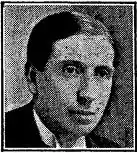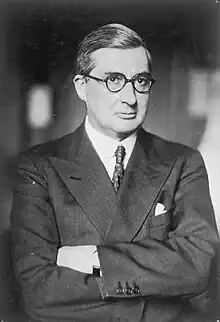| Cardiff East | |
|---|---|
| Former Borough constituency for the House of Commons | |
 Map of the proposed 2024 revived constituency in Wales | |
| 1918–1950 | |
| Seats | one |
| Created from | Cardiff |
| Replaced by | Cardiff North and Cardiff South East |
Cardiff East was a parliamentary constituency in Cardiff which returned one Member of Parliament to the House of Commons of the Parliament of the United Kingdom from 1918 until it was abolished for the 1950 general election.
The constituency is to be re-established, as part of the 2023 Periodic Review of Westminster constituencies and under the June 2023 final recommendations of the Boundary Commission for Wales for the next United Kingdom general election.[1]
Boundaries
The County Borough of Cardiff wards of Park, Roath, and Splott.
Members of Parliament
| Election | Member | Party | |
|---|---|---|---|
| 1918 | Sir William Seager | Liberal | |
| 1922 | Lewis Lougher | Unionist | |
| 1923 | Sir Henry Webb | Liberal | |
| 1924 | Sir Clement Kinloch-Cooke | Unionist | |
| 1929 | James Edmunds | Labour | |
| 1931 | Owen Temple-Morris | Conservative | |
| 1942 by-election | Sir James Grigg | National | |
| 1945 | Hilary Marquand | Labour | |
| 1950 | constituency abolished | ||
Election results
Elections in the 1910s

| Party | Candidate | Votes | % | ±% | |
|---|---|---|---|---|---|
| Liberal | William Seager | 7,963 | 40.8 | ||
| Unionist | Colum Crichton-Stuart | 5,978 | 30.7 | ||
| Labour | Arthur Williams | 5,554 | 28.5 | ||
| Majority | 1,985 | 10.1 | |||
| Turnout | 19,495 | 64.6 | |||
| Liberal win (new seat) | |||||
Seager received Coalition Government endorsement letter which was later withdrawn
Elections in the 1920s
| Party | Candidate | Votes | % | ±% | |
|---|---|---|---|---|---|
| Unionist | Lewis Lougher | 8,804 | 36.8 | +6.1 | |
| Liberal | Henry Webb | 7,622 | 31.8 | −9.0 | |
| Labour | Arthur Williams | 7,506 | 31.4 | +2.9 | |
| Majority | 1,182 | 5.0 | N/A | ||
| Turnout | 23,932 | 81.0 | +16.4 | ||
| Registered electors | 29,532 | ||||
| Unionist gain from Liberal | Swing | +7.6 | |||

| Party | Candidate | Votes | % | ±% | |
|---|---|---|---|---|---|
| Liberal | Henry Webb | 8,536 | 35.8 | +4.0 | |
| Labour | Hugh Dalton | 7,812 | 32.7 | +1.3 | |
| Unionist | Lewis Lougher | 7,513 | 31.5 | −5.3 | |
| Majority | 724 | 3.1 | N/A | ||
| Turnout | 23,861 | 79.3 | −1.7 | ||
| Registered electors | 30,100 | ||||
| Liberal gain from Unionist | Swing | +1.4 | |||

| Party | Candidate | Votes | % | ±% | |
|---|---|---|---|---|---|
| Unionist | Clement Kinloch-Cooke | 10,036 | 40.3 | +8.8 | |
| Labour | Harold Lloyd | 8,156 | 32.8 | +0.1 | |
| Liberal | Donald Maclean | 6,684 | 26.9 | −8.9 | |
| Majority | 1,880 | 7.5 | N/A | ||
| Turnout | 24,876 | 82.3 | +3.0 | ||
| Registered electors | 30,218 | ||||
| Unionist gain from Liberal | Swing | +4.4 | |||

| Party | Candidate | Votes | % | ±% | |
|---|---|---|---|---|---|
| Labour | James Edmunds | 12,813 | 39.0 | +6.2 | |
| Liberal | John Emlyn-Jones | 10,500 | 31.9 | +5.0 | |
| Unionist | Clement Kinloch-Cooke | 9,563 | 29.1 | −11.2 | |
| Majority | 2,313 | 7.1 | N/A | ||
| Turnout | 32,876 | 82.1 | −0.2 | ||
| Registered electors | 40,061 | ||||
| Labour gain from Unionist | Swing | +0.6 | |||
Elections in the 1930s
| Party | Candidate | Votes | % | ±% | |
|---|---|---|---|---|---|
| Conservative | Owen Temple-Morris | 12,465 | 38.6 | +8.5 | |
| Labour | James Edmunds | 10,292 | 31.8 | -7.2 | |
| Liberal | John Emlyn-Jones | 9,559 | 29.6 | -2.3 | |
| Majority | 2,173 | 6.8 | N/A | ||
| Turnout | 32,316 | 80.2 | -7.9 | ||
| Conservative gain from Labour | Swing | ||||
| Party | Candidate | Votes | % | ±% | |
|---|---|---|---|---|---|
| Conservative | Owen Temple-Morris | 16,048 | 53.4 | +14.8 | |
| Labour | William Bennett | 11,362 | 37.8 | +6.0 | |
| Liberal | Aubrey Willis Pile | 2,623 | 8.7 | -20.9 | |
| Majority | 4,686 | 15.6 | +8.8 | ||
| Turnout | 30,033 | 73.1 | -8.1 | ||
| Conservative hold | Swing | ||||
Elections in the 1940s
General Election 1939–40:
Another General Election was required to take place before the end of 1940. The political parties had been making preparations for an election to take place from 1939 and by the end of this year, the following candidates had been selected;
- Conservative: Owen Temple-Morris

| Party | Candidate | Votes | % | ±% | |
|---|---|---|---|---|---|
| National | James Grigg | 10,030 | 75.2 | New | |
| Ind. Labour Party | Fenner Brockway | 3,311 | 24.8 | New | |
| Majority | 6,719 | 50.4 | N/A | ||
| Turnout | 13,341 | 33.1 | -40.0 | ||
| National gain from Conservative | Swing | ||||
| Party | Candidate | Votes | % | ±% | |
|---|---|---|---|---|---|
| Labour | Hilary Marquand | 16,299 | 50.7 | +12.9 | |
| National | James Grigg | 11,306 | 35.2 | N/A | |
| Liberal | John Emlyn-Jones | 4,523 | 14.1 | +5.4 | |
| Majority | 4,993 | 15.5 | N/A | ||
| Turnout | 32,128 | 74.9 | +1.8 | ||
| Labour gain from National | Swing | ||||
References
Craig, F. W. S. (1983). British parliamentary election results 1918–1949 (3 ed.). Chichester: Parliamentary Research Services. ISBN 0-900178-06-X.